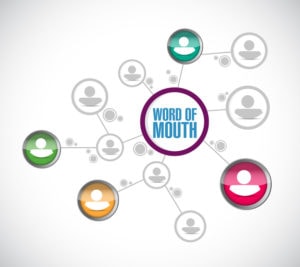
Ana Babic Rosario
Ana Babić Rosario was a PhD student at HEC Paris and is now Evelyn and Jay G. Piccinati Associate Professor of Marketing at the Daniels College of Business. She co-authored this piece with HEC Professor of Marketing Kristine de Valck and VU Amsterdam Professor of Marketing Francesca Sotgiu. The article summarizes their recent research, “Conceptualizing the electronic word-of-mouth process: What we know and need to know about eWOM creation, exposure and evaluation,” which was published in the December 2019 issue of the Journal of the Academy of Marketing Science.
“The Effect of Electronic Word of Mouth on Sales: A Meta-Analytic Review of Platform, Product, and Metric Factors” was published in 2016 in the Journal of Marketing Research. Since this story originally published in May 2020, the article was a finalist for the Journal’s Weitz-Winer-O’Dell award. In the last five years, it’s received more than 650 citations on Google Scholar.
Introduction to Electronic Word of Mouth (eWOM)
Today’s marketplace is heavily influenced by the internet, which has changed the way consumers make decisions about their purchases: They won’t rely solely on marketer-generated information (ads or salespeople). Instead, they look up reviews on sites such as TripAdvisor or Yelp, check customer testimonials on e-commerce websites, and look at other people’s recommendations. In other words, they turn to electronic word of mouth (eWOM).
Marketers can take steps to generate, support, and amplify eWOM to influence consumers’ decision-making process. My co-authors and I have laid out an eWOM roadmap to help marketers and academics understand its inner workings and enhance its effects.
eWOM is a powerful market force, because consumers find it an unbiased and trustworthy source of product information. Over the past two decades, a lot of research has investigated the role of eWOM in the marketplace. In this article, we take stock of that knowledge and offer marketers a roadmap about how eWOM works so that they are better equipped to manage this marketplace phenomenon, and, eventually, boost product sales.

Clarifying the Definition of eWOM
Before diving into the eWOM phenomenon, it’s important to delineate what eWOM is and what it isn’t. For example, critics’ reviews, electronic recommendation systems and general chatter on the internet have all been placed under the header of eWOM. Even though these phenomena are related, they are qualitatively different from eWOM.
In addition, definitions of eWOM have become outdated as they refer to “statements” or “textual postings,” while today’s consumers can engage in eWOM through other formats, such as photos and videos. We therefore introduce a revised definition of eWOM that addresses the confusion about this concept: eWOM is consumer-generated, consumption-related communication that employs digital tools and is directed primarily to other consumers.
This definition allows us to delineate the key components: the source (consumers as senders of eWOM), the message (consumption-related content), the channel (digital conversation tools), and the receiver (primarily other consumers).

The Three Stages of eWOM: Creation, Exposure and Evaluation
Having defined its key components, we further propose that eWOM consists of three key stages:
- For eWOM to have an effect in the marketplace, it first needs to be created.
- Then, consumers need to be exposed to it, because eWOM that is created but not noticed will not have any effect.
- Finally, for the effect to materialize, consumers need to evaluate the eWOM message and take it into account in their decision-making process.
Throughout these three stages consumers take on a dual role: They are eWOM creators—senders of information—and, when they are exposed or evaluating, they are eWOM receivers.
In our literature review, we focused on what we know about consumers’ motivations, opportunities and abilities to create, be exposed to, and evaluate eWOM. We also described what marketers can do in each of the three eWOM stages to influence consumer motivations, increase their opportunities and reinforce their abilities as senders and receivers of eWOM.
Strategies for Marketers to Influence eWOM Creation
Marketers can influence eWOM at any of the three stages. If they want to influence the creation of eWOM they must first ask, “Why do people create eWOM?” Our roadmap shows that there are many motivations for doing this, and these have evolved over time. For example, in the early days of the internet, consumers wrote posts about products because they genuinely wanted to help others in their consumer experience.
However, in more recent years, in line with the increased use of social media platforms such as Facebook and Instagram, people may have less altruistic motivations. Instead, they create posts for social recognition.
To make the most of eWOM and help initiate its creation, marketers need to understand these different motivations. To support altruistic eWOM creation, marketers can appeal to consumers by forwarding product-related questions asked by other consumers, as Amazon does, for example. To support eWOM created for social recognition, marketers can offer picture-perfect photo opportunities (e.g., Disneyland) and encourage consumers to share these on their social media accounts.
Case Study: Amazon’s New AI Reviews
After first launching reviews in 1995, Amazon introduced a new AI-generated feature in 2023 that aggregates common themes across reviews and provides highlights. According to Amazon, “the new AI-powered feature provides a short paragraph right on the product detail page that highlights the product features and customer sentiment frequently mentioned across written reviews to help customers determine at a glance whether a product is right for them.”
This is the biggest change we’re seeing in this space right now. This review summary is displayed on Amazon, generated by some large language model that is learning from the bulk of user-generated content. But it’s not quite user-generated content, because the AI does have some sort of liberty to interpret what consumers have said. That’s going to be something to keep an eye on going forward.
Looking Ahead: Challenges and Opportunities for Marketers
With the rise of the internet and social media, marketers’ jobs have become more complicated. They need to stay ahead of the game to be able to influence consumers’ purchase decisions.
Social media listening is a crucial part of the equation. Marketers need to listen to what the consumers are saying about their brand and then get engaged in that organic conversation. Beyond listening, brands also need to contribute to the conversations that consumers are starting.
The idea of controlling eWOM is an appealing one to companies, so we see them inviting consumers to use a specific hashtag or even generate memes. But this is complicated, and there is always an opportunity for something to go sour. So, companies should be careful about offering opportunities to consumers to contribute to stories that might become co-opted and turn negative (just think back to McDonald’s #McDStories).
Another challenge comes with the rise of voice-enabled assistants, such as Alexa. In a voice-only environment, the ease of scanning through multiple written reviews, comparing opinions and quickly identifying key information is lost. Consumers must rely on the assistant’s limited ability to summarize or selectively present reviews, often without the context or depth provided by text. This shift raises concerns about how effectively consumers can make informed decisions, as the richness of diverse opinions and the ability to easily explore and verify reviews become increasingly constrained.
Conclusion and Key Takeaways
In modern consumer decision making, eWOM is a significant influence. Understanding how to harness its power and follow a roadmap will help marketers in the future. As the digital landscape evolves, marketers must be able to adapt and effectively engage with online consumer conversations.

I agree with what the Author said, that e-WOM is an essential tool for marketing department. Marketers can take the support of e-WOM to influence consumer’s decision-making process. In this new era, the marketplace is highly influenced by the internet as many people are on social media, they prefer to shop online as it is way more easy than shopping outdoor. So these people depend highly on online reviews and comments published by other people to get more information about the product or service, before making their purchase intention. As said by the author, e-WOM can offer marketers a roadmap how to manage the marketplace and eventually increase the sales level. As mentioned the three key stages: creation, exposure and evaluation, marketers should always bear these in mind in order to stay ahead and updated. They need to consider what customers really look before buying online, do they rely more on negative e-WOM than positives ones, does e-WOM play a role in their mind before making purchases, and others. considering these factors will help marketers to be ahead in the game and to be able to influence consumers purchase decisions.